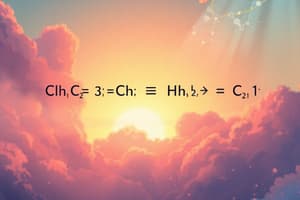Podcast
Questions and Answers
What is the first step in balancing a chemical equation?
What is the first step in balancing a chemical equation?
- Examine the equation and identify the first unbalanced element (correct)
- Add coefficients to all elements
- Include the physical states of the reactants and products
- Count the number of atoms on each side
Which element was first identified as unbalanced in the example equation 3Fe + 4H₂O → Fe₂O₃ + 4H₂?
Which element was first identified as unbalanced in the example equation 3Fe + 4H₂O → Fe₂O₃ + 4H₂?
- Hydrogen (H)
- Oxygen (O)
- Water (H₂O)
- Iron (Fe) (correct)
What should be checked after adjusting the coefficients in a balanced equation?
What should be checked after adjusting the coefficients in a balanced equation?
- The balance of atoms for each element on both sides (correct)
- The type of reaction that occurs
- The total mass of reactants vs products
- The accuracy of physical states
In the balanced equation 3Fe(s) + 4H₂O(g) → Fe₂O₃(s) + 4H₂(g), what does the symbol (s) represent?
In the balanced equation 3Fe(s) + 4H₂O(g) → Fe₂O₃(s) + 4H₂(g), what does the symbol (s) represent?
What additional information can be included in a chemical equation to clarify the reaction conditions?
What additional information can be included in a chemical equation to clarify the reaction conditions?
In the process of balancing, why is it important to add coefficients rather than changing the subscripts of compounds?
In the process of balancing, why is it important to add coefficients rather than changing the subscripts of compounds?
What is the purpose of using coefficients in a balanced equation?
What is the purpose of using coefficients in a balanced equation?
Which of the following is NOT a step in the balancing chemical equations procedure?
Which of the following is NOT a step in the balancing chemical equations procedure?
What indicates the physical state of water in the reaction CO(g) + 2H₂(g) → CH₃OH(l)?
What indicates the physical state of water in the reaction CO(g) + 2H₂(g) → CH₃OH(l)?
When balancing the equation, what is the correct final form of the equation after all steps are complete?
When balancing the equation, what is the correct final form of the equation after all steps are complete?
Flashcards are hidden until you start studying
Study Notes
Chemical Reactions and Equations
- A chemical reaction is a process in which one or more substances are converted into new substances.
- Chemical reactions involve changes in the chemical composition of substances.
- Chemical equations are a concise way to represent chemical reactions.
Writing a Chemical Equation
- Chemical equations can be written using chemical formulae instead of words.
- A chemical equation represents the reactants, products, and direction of a chemical reaction.
- Counting and comparing the number of atoms of each element on both sides of the arrow is essential to ensure the equation is balanced.
Balanced Chemical Equations
- A balanced chemical equation has the same number of atoms of each element on both sides of the arrow.
- The law of conservation of mass states that mass cannot be created or destroyed in a chemical reaction.
- Balancing a chemical equation involves making sure the number of atoms of each element is the same on both sides of the equation.
Activity 1.1
- Burning magnesium ribbon in air produces magnesium oxide.
- The reaction involves a change in state, color, evolution of gas, and change in temperature.
Activity 1.2 and 1.3
- Lead nitrate solution and potassium iodide solution react to form a precipitate.
- Zinc granules react with dilute hydrochloric acid or sulphuric acid to produce zinc sulphate and hydrogen gas.
Observations of Chemical Reactions
- Changes in state, color, evolution of gas, and change in temperature indicate a chemical reaction has taken place.
- Chemical reactions occur in daily life, such as milk spoiling, iron rusting, and food digestion.
Balancing Chemical Equations
Step I
- Draw boxes around each formula in the equation.
- Do not change anything inside the boxes while balancing the equation.
Step II
- List the number of atoms of different elements present in the unbalanced equation.
Step III
- Start balancing with the compound that contains the maximum number of atoms.
- Select the element which has the maximum number of atoms in that compound.
- Balance the atoms of the selected element.
Step IV
- Balance the atoms of other elements in the equation.
- Use coefficients to balance the equation, not altering the formulae of compounds or elements.
Step V
- Examine the result and ensure the equation is balanced.
- Count the atoms of each element on both sides of the equation.
Step VI
- Verify the balanced equation by counting atoms of each element on both sides.
- Write the balanced equation with the physical state of each element or compound.
Step VII
- Write the balanced equation with reaction conditions, such as temperature, catalyst, and physical states of reactants and products.
Studying That Suits You
Use AI to generate personalized quizzes and flashcards to suit your learning preferences.




